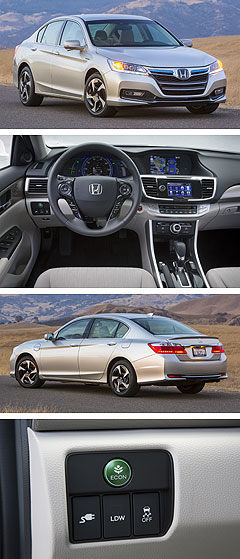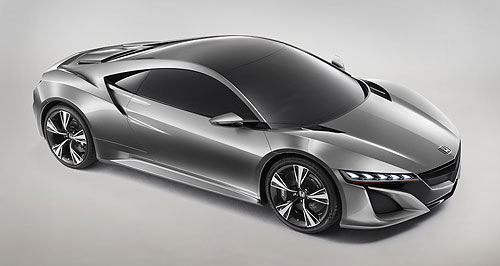Make / Model Search
News - HondaHonda hybrid promises 30 per cent fuel cutMild no more: Honda is preparing to replace its mild hybrids with serious petrol-electric powertrains, including a three-motor system for the forthcoming NSX supercar. Dual-clutch hybrid set to deliver major fuel economy gains in Honda small cars13 Nov 2012 HONDA has announced a new-generation small-car hybrid powertrain it says can deliver 30 per cent better fuel consumption than conventional hybrids, presumably including its own mild hybrid system employed in current petrol-electric versions of Civic, Jazz, Insight and CR-Z. This means a future Honda Civic equipped with the so-called Intelligent Dual Clutch Drive (i-DCD) system might achieve fuel economy as low at 3.0 litres per 100km – well under the 4.4L/100km combined cycle figure for the current Civic Hybrid with its Integrated Motor Assist (IMA) powertrain. Honda says the new system will not only deliver best-in-class fuel economy but also more fun, with faster acceleration. The powertrain was one of three new petrol-electric ‘sport hybrid’ systems detailed by Honda in Japan yesterday, encompassing one, two and three electric motors for cars ranging from light hatchbacks to the forthcoming new-generation NSX supercar. The first of the new powertrains will come on stream within months as part of Honda’s new Earth Dreams engine line-up, starting with a two-motor plug-in hybrid powertrain for a petrol-electric Accord in North America from January.  Left: Honda Accord PHEV. Left: Honda Accord PHEV.The single-motor system for small cars dispenses with the manual gearbox and continuously variable transmissions (CVT) of IMA, instead using a new seven-speed dual-clutch auto mated with a new 1.5-litre Atkinson cycle petrol engine – thought to be based on one of Honda’s forthcoming new-generation ‘Earth Dreams’ petrol engines. Unlike the IMA system that sandwiches an electric motor between the engine and transmission, the i-DCD system is said to have the motor built into the transmission, creating a light and compact drive system. Clutches within the transmission can engage and disengage the petrol engine when appropriate. For example, a car powered by the new system can drive purely on electricity at what Honda describes as “low- to medium-speed”, in the same way as Toyota hybrids. As well, the clutches can disengage the engine during deceleration and thus eliminate the engine-braking effect to allow the electric motor-generator to take more of the braking load to generate more electricity. Instead of Honda’s current nickel-metal hydride batteries to store the electricity from braking regeneration, the new system employs the more modern lithium-ion storage as employed in cars such as the Nissan Leaf and Holden Volt. Honda also outlined its new plug-in hybrid system – Multi Mode Drive (i-MMD) – that will make its debut in the new Honda Accord for North America from January. The company claims the system will deliver “the world’s highest efficiency” by combining a newly developed engine mated to two built-in electric motors and a lock-up clutch. Drawing on electricity stored in a lithium-ion battery that can be charged from a home socket, the powertrain can run in three modes: pure electricity, on petrol with the engine connected directly to the wheels via the lock-up clutch for highway cruising, or hybrid drive using a combination of both electricity and petrol engine for urban driving. Honda claims the system delivers both brisk acceleration and EV-like driving feel, switching between the modes according to driving conditions and battery charge level. It is unclear if other Honda cars will get the system, but it is likely to be spread across Honda’s North American Acura luxury mid-sized models. Honda’s new NSX, which was previewed in concept form at this year’s Detroit motor show, is expected to be one of the recipients of Honda’s top-end three-motor hybrid system. However, the ‘Super-Handling All-Wheel-Drive’ system is expected to debut in the American hybrid version of the Legend flagship sedan, the Acura RLX, which is tipped to be unveiled at the Los Angeles motor show later this month ahead of a 2013 US showroom debut. The system mates a new direct-injected 3.5-litre V6 with three electric motors and a seven-speed dual-clutch transmission, and promises to deliver the economy of a four-cylinder engine with the acceleration of a V8. Two of the motors are fitted at the back of the mid-engined car to distribute torque independently on the left and right wheels. “Using independent motors for the right and left rear wheels, positive torque is applied to the outside wheel and negative torque is applied to the inside wheel, making independent control of torque distribution to the rear wheels possible without relying on engine output,” Honda says. “Depending on the radius of the curve, the energy generated by the inside wheel is recovered electrically and applied to the outside wheel to self-generate torque necessary for the vehicle to make the turn.” The system is expected to be employed with a new electronically controlled all-wheel-steer system that can be more finely tuned than the mechanical 4WS systems developed by Honda in the 1980s. The new system can even provide rear-wheel toe-in for great braking stability.  Read more |
Click to shareHonda articlesResearch Honda Motor industry news |











Facebook Twitter Instagram